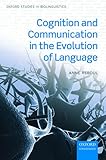Cognition and communication in the evolution of language / Anne Reboul.
Material type: TextSeries: Oxford studies in biolinguistics: Publisher: Oxford : Oxford University Press, 2017Copyright date: ©2017Edition: First editionDescription: xii, 261 pages ; 24 cmContent type: text Media type: unmediated Carrier type: volumeISBN: 9780198747314; 0198747314Subject(s): Language and languages -- Origin | Psycholinguistics | Biolinguistics | Biolinguistics | Language and languages -- Origin | Psycholinguistics | Kognition | Kommunikation | SprachentwicklungDDC classification: 410 LOC classification: P37 | .R43 2017
TextSeries: Oxford studies in biolinguistics: Publisher: Oxford : Oxford University Press, 2017Copyright date: ©2017Edition: First editionDescription: xii, 261 pages ; 24 cmContent type: text Media type: unmediated Carrier type: volumeISBN: 9780198747314; 0198747314Subject(s): Language and languages -- Origin | Psycholinguistics | Biolinguistics | Biolinguistics | Language and languages -- Origin | Psycholinguistics | Kognition | Kommunikation | SprachentwicklungDDC classification: 410 LOC classification: P37 | .R43 2017| Item type | Current library | Call number | Copy number | Status | Notes | Date due | Barcode |
|---|---|---|---|---|---|---|---|
 Books
Books
|
Female Library | P37 .R43 2017 (Browse shelf (Opens below)) | 1 | Available | STACKS | 51952000338185 | |
 Books
Books
|
Main Library | P37 .R43 2017 (Browse shelf (Opens below)) | 1 | Available | STACKS | 51952000338192 |
Browsing Female Library shelves Close shelf browser

|

|

|

|

|

|

|
||
| P35 .G84 2016 Language, culture, identity and citizenship in college classrooms and communities / | P37 .A37 2007 The articulate mammal : an introduction to psycholinguistics / | P37 .F54 2003 Psycholinguistics : a resource book for students / | P37 .R43 2017 Cognition and communication in the evolution of language / | P37.5 .C74 C37 2004 Language and creativity : the art of common talk / | P37.5.S65 .P85 2017 Prescription and tradition in language : establishing standards across time and space / | P371 .K38 2002 The languages of the world / |
Introduction -- The need for a dual account of language evolution -- The specificity of the human conceptual apparatus -- Merge and the lexicalization of concepts -- A mildly Machiavellian view of communication and the Argumentative Theory of Reasoning -- Conclusion.
This book proposes a new two-step approach to the evolution of language, whereby syntax first evolved as an auto-organizational process for the human conceptual apparatus (as a Language of Thought), and this Language of Thought was then externalized for communication, due to social selection pressures. Anne Reboul first argues that despite the routine use of language in communication, current use is not a failsafe guide to adaptive history. She points out that human cognition is as unique in nature as is language as a communication system, suggesting deep links between human thought and language. If language is seen as a communication system, then the specificities of language, its hierarchical syntax, its creativity, and the ability to use it to talk about absent objects, are a mystery. This book shows that approaching language as a system for thought overcomes these problems, and provides a detailed account of both steps in the evolution of language: its evolution for thought and its externalization for communication.
Includes bibliographical references (pages 233-250) and index.
1 2

There are no comments on this title.